Well the title pretty much sums it up. In trying to be as transparent as we can here is a short video explaining how we get the numbers we do. This is the first of many education videos to come. We want you guys to understand what we can see with the PULSE and how and why we use the numbers we do.
Join the Hide community
Get access to live stream, lessons, the post exchange, and chat with other snipers.
Register
Download Gravity Ballistics
Get help to accurately calculate and scope your sniper rifle using real shooting data.

Install the app
How to install the app on iOS
Follow along with the video below to see how to install our site as a web app on your home screen.
Note: This feature may not be available in some browsers.
You are using an out of date browser. It may not display this or other websites correctly.
You should upgrade or use an alternative browser.
You should upgrade or use an alternative browser.
Suppressors Thunder Beast How and why we test the way we do. Education video#1
- Thread starter TBACRAY
- Start date
Close ups of the plots
Attachments
-
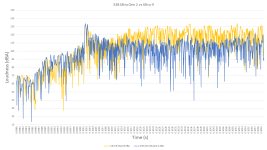 Slide4.PNG133.3 KB · Views: 139
Slide4.PNG133.3 KB · Views: 139 -
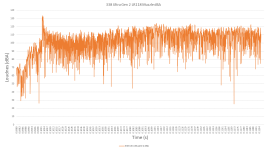 Slide5.PNG54.4 KB · Views: 126
Slide5.PNG54.4 KB · Views: 126 -
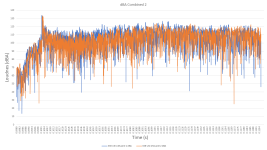 Slide6.PNG102.3 KB · Views: 110
Slide6.PNG102.3 KB · Views: 110 -
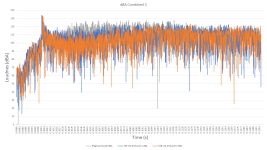 Slide7.PNG117 KB · Views: 114
Slide7.PNG117 KB · Views: 114 -
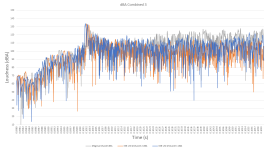 Slide8.PNG158.5 KB · Views: 119
Slide8.PNG158.5 KB · Views: 119 -
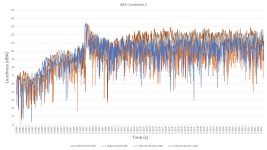 Slide9.PNG185.4 KB · Views: 128
Slide9.PNG185.4 KB · Views: 128 -
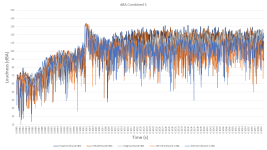 Slide10.PNG207.3 KB · Views: 112
Slide10.PNG207.3 KB · Views: 112 -
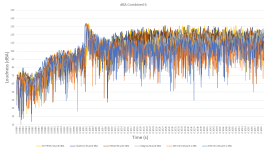 Slide11.PNG222.1 KB · Views: 114
Slide11.PNG222.1 KB · Views: 114 -
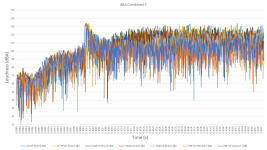 Slide12.PNG234.9 KB · Views: 109
Slide12.PNG234.9 KB · Views: 109 -
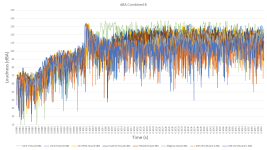 Slide13.PNG251.2 KB · Views: 122
Slide13.PNG251.2 KB · Views: 122 -
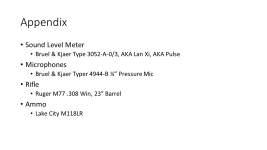 Slide14.PNG17.6 KB · Views: 115
Slide14.PNG17.6 KB · Views: 115 -
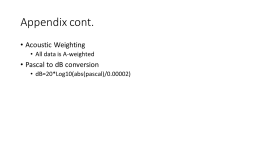 Slide15.PNG11.8 KB · Views: 141
Slide15.PNG11.8 KB · Views: 141
It almost seems like looking at the area under the graph line down to a set floor, like 120dB, could provide some meaningful information. For instance the Magnus does peak higher than the 338 g2 but it quickly settles in at about the same level. Would that imply actual hearing damage or perceived loudness might put these two closer together in total suppression levels?
The problem is when you tell everyone they're buying 113db can but they're actually experiencing 123db at the ear. I get why you want to analyze it like that but there's a big difference when you clipped 10db.
The can does its job to that level. The SS crack is ever present.
The product pages that have data will have a link to the video explanation and a note about the SS crack dB.
The product pages that have data will have a link to the video explanation and a note about the SS crack dB.
"The problem is when you tell everyone they're buying 113db can but they're actually experiencing 123db at the ear. I get why you want to analyze it like that but there's a big difference when you clipped 10db."
This is why we would like some kind of real industry standard and are showing you how and why we do it this way. We are not against the idea of using duration and math to come up with a number but that has to be open for others to replicate.
This is why we would like some kind of real industry standard and are showing you how and why we do it this way. We are not against the idea of using duration and math to come up with a number but that has to be open for others to replicate.
Last edited:
Here's some background. The NATO spec specifically instructs to omit the shockwave (what we've been calling the SS crack), and have a defined window after the shockwave to measure in, and also to omit ground reflections, etc. They presumably had to deal with the problem of the shockwave dominating the suppressor report sooner because they meter at 5M not 1M. We used this document to cross check our methodology.



Link to the PDF
NATO STANDARD AEP-4785 Suppressor Testing Protocol on Acoustic Signature Measurement of Small Arms Suppressors Edition A Version 1 November 2015



Link to the PDF
NATO STANDARD AEP-4785 Suppressor Testing Protocol on Acoustic Signature Measurement of Small Arms Suppressors Edition A Version 1 November 2015
Not yet, we'll have to do it after SHOTSpeaking of supersonic crack to someone thirsty for the new offerings—do you guys have a video shooting subsonic 308 and 300blk out the magnus/338 gen 2?
You can do it in the venue, it'll probably be quieter than the exhibition floor.Not yet, we'll have to do it after SHOT
"The problem is when you tell everyone they're buying 113db can but they're actually experiencing 123db at the ear. I get why you want to analyze it like that but there's a big difference when you clipped 10db."
This is why we would like some kind of real industry standard and are showing you how and why we do it this way. We are not against the idea of using duration and math to come up with a number but that has to be open for others to replicate.
FWIW, I own some of your silencers and I think you're honest. Whatever you publish has to include exactly what the shooter experiences otherwise it is untrue. There's obviously more to the story but there has to be the maximum peak included. If I bought your new silencer expecting 113db at the ear it would take exactly one shot to know that number was untrue. What militaries and governments do is none of my concern.
Thank you for that.
What we are doing for now is listing the blast suppression number and listing the shockwave dB range along with the test procedure notes.
The difference between a 111 dB (muzzle blast) + 122 dB (shockwave) suppressor and a 122 dB (muzle blast) + 122 dB (shockwave) suppressor is very dramatic at the ear.
What we are doing for now is listing the blast suppression number and listing the shockwave dB range along with the test procedure notes.
The difference between a 111 dB (muzzle blast) + 122 dB (shockwave) suppressor and a 122 dB (muzle blast) + 122 dB (shockwave) suppressor is very dramatic at the ear.
"FWIW, I own some of your silencers and I think you're honest. Whatever you publish has to include exactly what the shooter experiences otherwise it is untrue. There's obviously more to the story but there has to be the maximum peak included. If I bought your new silencer expecting 113db at the ear it would take exactly one shot to know that number was untrue. What militaries and governments do is none of my concern."
First off thanks for owning our cans. We are trying to be open and push for a standard. Like Zak pointed out sonic crack and blast have way different durations.
If I put a suppressor on that matched the crack and put the Magnus on you would hear the difference without a doubt. Thats why 338 cans sound so good on sub calibers. Lots of manufacturers to talk to at SHOT. We will come up with a way that includes the sonic crack but still shows what can performs better. Main reason of this video was to get this whole thing going.
First off thanks for owning our cans. We are trying to be open and push for a standard. Like Zak pointed out sonic crack and blast have way different durations.
If I put a suppressor on that matched the crack and put the Magnus on you would hear the difference without a doubt. Thats why 338 cans sound so good on sub calibers. Lots of manufacturers to talk to at SHOT. We will come up with a way that includes the sonic crack but still shows what can performs better. Main reason of this video was to get this whole thing going.
We will come up with a way that includes the sonic crack but still shows what can performs better. Main reason of this video was to get this whole thing going.
That is all anyone can ask for. Thank you for being receptive to feedback.
This is probably a good time to note that the potential for ear damage is dependent mainly upon momentum transfer potential (AKA impulse, or "area under the curve"), and not the peak pressure of any single component of the sound signature. This is why it's generally considered OK to ignore the sonic crack of the bullet, action closing noise, refections, etc.
But how many people shopping for a suppressor just look at a single number on manf sites and compares them with absolutely zero knowledge of what is behind these figures.There's obviously more to the story but there has to be the maximum peak included.
I'm glad they are now showing shockwave in addition to blast suppression....but to just have changed their one number would be, I think, committing competitive suicide...no?
And that is why I support some sort of standard so that diff manf can't cherry pick a number.
Just my thoughts as I wait for my Ultra 7 to get out of jail! haha
We could show all the large OD cans and all the 338 cans and include the shockwave and they'll all meter at pretty much the same number. It's not really a useful exercise other than to demonstrate that they're all quieter than the shockwave. We could shoot that on video after SHOT.
I really appreciate TBACs transparency with the metering methodology. It’s hard to judge when everyone has a different measuring stick.We could show all the large OD cans and all the 338 cans and include the shockwave and they'll all meter at pretty much the same number. It's not really a useful exercise other than to demonstrate that they're all quieter than the shockwave. We could shoot that on video after SHOT.
As a related aside to the supersonic crack hubbub, did you know a small child can produce sounds up to 120dB when crying?

The Cry of the Child and its Relationship to Hearing Loss in Parental Guardians and Health Care Providers - PubMed
In this study the authors investigate the sound pressure levels produced by crying children and discuss the possible adverse effects that direct exposure may impose on a tending guardian or healthcare professional. Sound intensity levels from various pediatric patients (N = 26) were measured...
When they do it on purpose pretty sure it exceeds 130



Maybe we’ll get that on the meter too
Maybe we’ll get that on the meter too
But how many people shopping for a suppressor just look at a single number on manf sites and compares them with absolutely zero knowledge of what is behind these figures.
I'm glad they are now showing shockwave in addition to blast suppression....but to just have changed their one number would be, I think, committing competitive suicide...no?
And that is why I support some sort of standard so that diff manf can't cherry pick a number.
Just my thoughts as I wait for my Ultra 7 to get out of jail! haha
If they'll exclude the peak they'll get accused of cherry picking that too. Just show both, it's the entire story after all.
Hey @Zak Smith @TBACRAY @kurtispalu
I was looking through some B&K documentation and noticed that it appears possible to measure and report Auditory Risk Units (ARU) per the AHAAH. Any chance of publishing those numbers for your products? I know that number isn't as familiar to users as peak dB measurements, but it'd be a lot more useful in determining how much shooting volume might be tolerable to "warned" and "unwarned" ears.
I was looking through some B&K documentation and noticed that it appears possible to measure and report Auditory Risk Units (ARU) per the AHAAH. Any chance of publishing those numbers for your products? I know that number isn't as familiar to users as peak dB measurements, but it'd be a lot more useful in determining how much shooting volume might be tolerable to "warned" and "unwarned" ears.
Hi,
In the version we have (23), there is a way to export to .wav and then import to the separate AHAAH software to do that.
We are moving towards posting additional metrics. We'd "like" this to be in some agreed-on standard via the ASA
In the version we have (23), there is a way to export to .wav and then import to the separate AHAAH software to do that.
We are moving towards posting additional metrics. We'd "like" this to be in some agreed-on standard via the ASA
Hi,
In the version we have (23), there is a way to export to .wav and then import to the separate AHAAH software to do that.
We are moving towards posting additional metrics. We'd "like" this to be in some agreed-on standard via the ASA
That'd be cool. As as engineer, I love to see raw waveforms, but it seems far more useful to the public to simply generate a standardized value based upon ARU and let the customer decide what level of performance is appropriate for his needs.
The AHAAH software seems really good on the surface and I like the idea of a daily exposure limit. However I do not like how the data is imported into AHAAH. You import your .wave file and then input what your units and peak value are. This is a method that is rife with error and/or funny business.That'd be cool. As as engineer, I love to see raw waveforms, but it seems far more useful to the public to simply generate a standardized value based upon ARU and let the customer decide what level of performance is appropriate for his needs.
Not quite.Anyone who wants real suppressor comparisons log onto Pew Pew Science, they rate all F4 cans. The Hyperion is the quietest F4 can on the market.
Later with 6.5 ammo some newer cans (Hyperion not in this test).
Not quite.
Later with 6.5 ammo some newer cans (Hyperion not in this test).
Check Pew Pew or any other independent testing, all db numbers from manufacturers are sketchy
Watch the video and quit being a shill. You see them all tested right in a row. Also in the first video they were beat by other companies.Check Pew Pew or any other independent testing, all db numbers from manufacturers are sketchy
WTF are talking about???? Shill, I don't own any F4 cans, I only have F1 cans, I c an build better cans than I can buy. I watched the video, yeah all the can at the sonic crack are all 132 db ?? BullshitWatch the video and quit being a shill. You see them all tested right in a row. Also in the first video they were beat by other companies.
Anyone who wants real suppressor comparisons log onto Pew Pew Science, they rate all F4 cans. The Hyperion is the quietest F4 can on the market.
You have a unique definition of "all".
This is some B.S....I haven't seen Ray in about a decade...and that mofo doesn't look any older. Wtf.
I'm gonna go spend some time in my cry room...with all my gray hair.
Branden
I'm gonna go spend some time in my cry room...with all my gray hair.
Branden
Don't feel too bad, he keeps his cheaters off screen.This is some B.S....I haven't seen Ray in about a decade...and that mofo doesn't look any older. Wtf.
I'm gonna go spend some time in my cry room...with all my gray hair.
Branden
Anyone who wants real suppressor comparisons log onto Pew Pew Science, they rate all F4 cans. The Hyperion is the quietest F4 can on the market.
oso1 you really are showing your ignorance. Tell me how Pew comes up with the number being used to compare suppressors. Show me the math used so I can verify. Just the math is all you have to post here, I'll be waiting.
If you can make better cans than you can buy start a company and make your millions man.
WTF are talking about???? Shill, I don't own any F4 cans, I only have F1 cans, I c an build better cans than I can buy. I watched the video, yeah all the can at the sonic crack are all 132 db ?? Bullshit
oso1 you really are showing your ignorance. Tell me how Pew comes up with the number being used to compare suppressors. Show me the math used so I can verify. Just the math is all you have to post here, I'll be waiting.
If you can make better cans than you can buy start a company and make your millions man.
Similar threads
- Replies
- 5
- Views
- 496
- Replies
- 44
- Views
- 2K
- Replies
- 19
- Views
- 1K
Rifle Scopes
Revisiting drop testing
- Replies
- 184
- Views
- 6K
- Replies
- 138
- Views
- 15K
